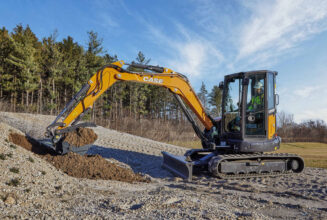Landscape Newcomers
By Leslie Kirk and Don Eberly
Every year, thousands of new plant varieties are released by professional breeders and growers to the horticulture and landscape industries. It can be a challenge for busy landscape designers, managers and contractors to find time to familiarize with those plants that satisfy their aesthetic and performance needs. However, being acquainted with new and exceptional varieties is essential to unveil fresh ideas to both residential and commercial clients, as well as incorporate unique live good elements to the landscape.
Breaking down new plant material into categories may help in identifying the value of each new plant and how it can well suit future installation projects. Some of the newest plants are improvements upon older varieties; others are new and updated series or varieties that compete with existing brands’ products. Still others nobly attempt to solve long-term maintenance problems. Then there are the standouts — the varieties that stop tradeshow-goers in their tracks, turn heads, and, sometimes, drop jaws. It is inspiring to find plants that shine among the hundreds of new colors and selections on the market. In recent years, plant breeders and growers have stepped up their cultivation efforts to make such great plants available for consumers’ enjoyment and for landscapers’ benefit.
“As growers, we must put out premium plant selections each year, and the task is getting more interesting as energy prices increase and consumers and businesses have to decide where to spend and where to save,” said Linda Guy, new product development director for Novalis Plants that Work and Plants that Work By Color. “With consumers watching their spending and businesses cutting budgets, we want to make the most unique and beautiful plants available to landscapers in ways that decrease replacement and maintenance for them.”
Guy and the other Novalis network growers work each year to supply landscapers with superior plant genetics and varieties that have been trialed regionally. “This means the plants used by the landscapers have already been tested in, and are appropriate for, their specific regions.” According to the network, landscape customers have said the ultimate goal must be robust plant selections that stand the region’s test of time and conditions. “Our grower network takes this need very seriously,” said Guy.
Likewise, landowners are beginning to demand their landscapes cater to eco-friendly standards. Consumers are becoming more aware of their own carbon footprint and that of the products that surround them. As a result, growers’ attentions have turned toward developing more sustainable options for the horticultural world. “Many of today’s new varieties are bred for disease resistance to reduce the use of harmful pesticides,” said Dan Heims, president and co-owner of Oregon-based Terra Nova Nurseries. “Heat and humidity tolerance also reduces wasteful watering, which is all too important today when concern for our resources is high and restrictions are common.”
Heims and his team of breeders have introduced more than 600 new varieties over the years, many of which are found in residential and large commercial landscapes from coast to coast. One of Terra Nova Nurseries’ objectives each year is to provide distinctive flowering perennials and shrubs coupled with unusual foliage textures and colors. “This gives landscapers a diverse menu of options to create a sense of place and style for their customers,” said Heims.
Plant experts like these develop plants that accommodate consumers’ quest for unique, striking varieties that capture attention and follow important trends related to outdoor plant preferences. Many of these offerings also support landscapers’ needs with new tolerance for pest pressures and weather extremes. In the end, knowing about the latest plant variety developments lends to a more informed installation project and successful maintenance job.
Nine notables for 2009
Nemesia ‘Bedazzle Topaz,’ part of the Novalis Plants that Work by Color collection, covers itself with delicate, baby pink flowers that feature bright orange lips and primrose-yellow flags. Originally from the Cape of South Africa, Topaz is bushy and neat in habit. “Topaz blooms throughout the summer season, and new flowers appear again once the weather cools,” said Guy. “It is an excellent winter variety in warmer climates.” Topaz thrives in full sun and reaches 10 inches tall with an 18-inch spread. It is hardy to USDA Zone 11 and performs best when fertilized at least once monthly. Novalis Plants that Work by Color offers a palette of vigorous color choices to harmonize in hue and/or texture with this variety.
With few plants in the orchid family suited for the outdoors, Bletilla ochracea ‘Chinese Butterfly’ offers uncommon landscape possibilities. “Exclusive to the Novalis Plants that Work collection for 2009, ‘Chinese Butterfly’ features creamy-yellow flowers, accented by a dotted, maroon lip. In the spring, these flowers are poised on delicate wands, blooming well into summer,” said Guy. This variety is an exquisite shade perennial. Over time, ‘Chinese Butterfly’ will form large clumps to provide a large presence in the landscape, and it combines very well aesthetically with ferns. Hardy to USDA Zones 6b-9, ‘Chinese Butterfly’ reaches 12 to 15 inches tall. It is ideal for mulched, woodland gardens and prefers moist, well-drained soil.
Often referred to as Northern Bush Honeysuckle, Diervilla sessilifolia ‘Cool Splash’ is an inaugural variegated form of Diervilla and will stop passers-by in their paths. Panicles of yellow trumpets cover this striking, variegated foliage, which will add a whole new dimension to the landscape in late May or early June. “’Cool Splash’ is a densely branched deciduous shrub that forms underground suckers, which develop into colonies over time,” said Guy. “When it is planted en masse in certain settings, like woodland gardens, it is absolutely spectacular.” Hardy to USDA Zones 4-9, it reaches an average height of two to three feet and thrives in part shade and moist, well-drained soil. The plant is part of the Novalis Plants that Work collection.
Silver Vase, Incorporated offers an eco-friendly Vriesea ‘Splenriete’ bromeliad, grown clean and green under set IPM practices to provide pesticide-residue-free plants. ‘Splenriete’ has a double stem, which offers added value for landscapers, with the perception of getting two plants for the price of one. As a double-stem variety, ‘Splenriete’ offers a hardier plant that has enough energy and nutrients to sustain two spikes and live longer. It will bloom for a minimum of eight weeks. Its bright-red blooms with variations of deep green and pale olive foliage make ‘Splenriete’ a novelty offering in high-temperature climates. Keep plants out of direct sun and water once every 10 to 14 days, when the media is dry. This is an ideal variety for interiorscapers with large interior beds to fill in office buildings and complexes.
“Few plants are as charming in the landscape as Dianthus gratianopolitanus ‘Petite’,” said Fran Hopkins, president and founder of Stepables, a line of creeping perennials. “This drought-tolerant creeper features light-gray foliage that fits snugly on the ground and covers completely, wherever it goes.” Tiny pink flowers bloom on short spikes in early summer. Dianthus ‘Petite’ fills in perfectly around taller perennials, between pavers or as a lawn substitute. It should be planted in soil or gravel but needs sharp drainage to be fully content. It is hardy to USDA Zone 4 and reaches only one inch in height, offering an alternative to turf. Plants should be spaced six inches apart in full to part sun for best results.
Small, brilliant-green leaves weave a super-tight mat on top of the ground and underneath with Pratia pendunculata ‘Alba’, also known as Super Star Creeper, a superb lawn substitute. Bright white, tiny flowers completely encompass this amazing Stepables creeper in late spring. ‘Alba’ should be planted between stones, over flower bulbs and around roses. It works great as a bark and mulch substitute around shrubs. Hardy to USDA Zone 6b, it thrives in full to part sun, reaches three inches in height and, as a vigorous grower, should be spaced eight inches apart.
Veronica ‘Purpleicious’ is a Showcase Variety offered by Garden Splendor in 2009, selected for its optimum performance in the landscape. “’Purpleicious’ is the darkest purple-flowered, spiked speedwell available,” said David Wilson, marketing director for Garden Splendor. “This veronica is bushy and compact with long-lasting, free-flowering blooms above dark-green, glossy foliage – just perfect for so many landscape solutions.” This perennial is excellent for beds and borders, foundational plantings, cottage garden designs, mixed borders, and container compositions. ‘Purpleicious’ reaches a mature height of about 18 inches and is best planted in full sun to partial shade. This and the other seven Garden Splendor Showcase varieties lend to tiers of plantings that increase curb appeal.
“As the first tomato red Echinacea on the market, ‘Tomato Soup’ is expected to be a top landscaper pick for 2009,” said Heims. “The plant features stunning, five-inch, tomato red flowers that bloom in stark contrast with a deep-black eye.” A well-branched perennial, ‘Tomato Soup’ will reach up to three feet tall and nearly as wide at maturity, showing excellent vigor until frost. Hardy to USDA Zones 4-9, ‘Tomato Soup’ has a clumping, upright habit that makes it easy to grow in full sun with good drainage. Blooming is prolonged by deadheading.
Tiarella ‘Mystic Mist’ is an excellent plant for four-season landscape intrigue. Bred by Terra Nova Nurseries for vigor, this Tiarella offers landscapers bright-green foliage with white, speckled variegation and red veins from spring to fall. In spring, white, foam-like flowers bloom. “This vigorous foamy bells selection is wonderful as an accent or planted as a group, with striking pink tones apparent in fall and winter that add a little extra burst of color to a landscape design,” said Heims. With a clumping habit, the plant reaches five inches tall with flowers stretching to nine inches, and an 11-inch spread. ‘Mystic Mist’ is hardy to USDA Zones 4-8 and requires part shade and moist, well-drained media.
Leslie Kirk is public relations manager, and Don Eberly is co-owner, of Eberly & Collard Public Relations, a national PR and advertising firm specializing in the home, garden, design, and agribusiness industries. Eberly & Collard Public Relations manages marketing and publicity for growers, landscape designers/architects, builders, and a diverse range of home/garden product and service companies. They can be reached at 404-574-2900.
For more information about these plants, as well as other varieties, visit the following resources online:
Garden Splendor — www.gardensplendor.com
Novalis Plants that Work and Plants that Work by Color — www.novalis.com or www.plantsthatwork.com
Silver Vase, Incorporated — www.silvervase.com
Stepables — www.stepables.com
Terra Nova Nurseries — www.terranovanurseries.com


